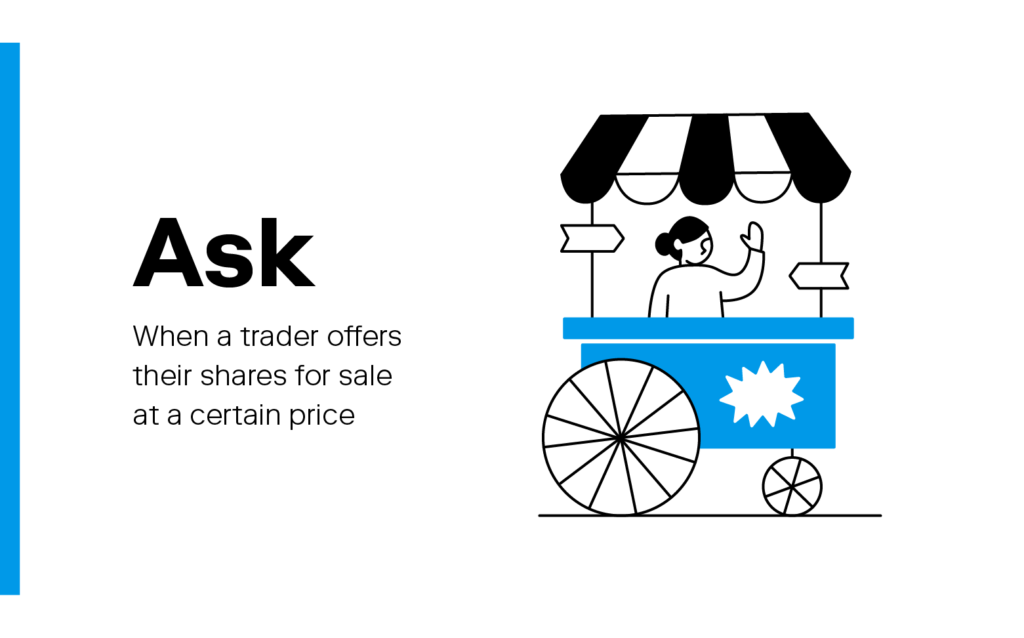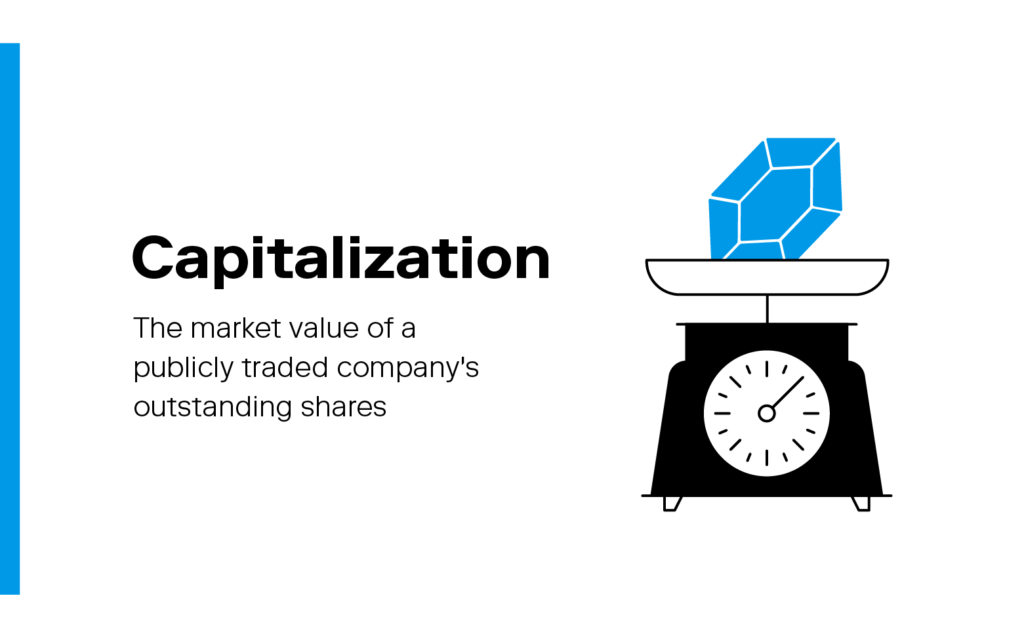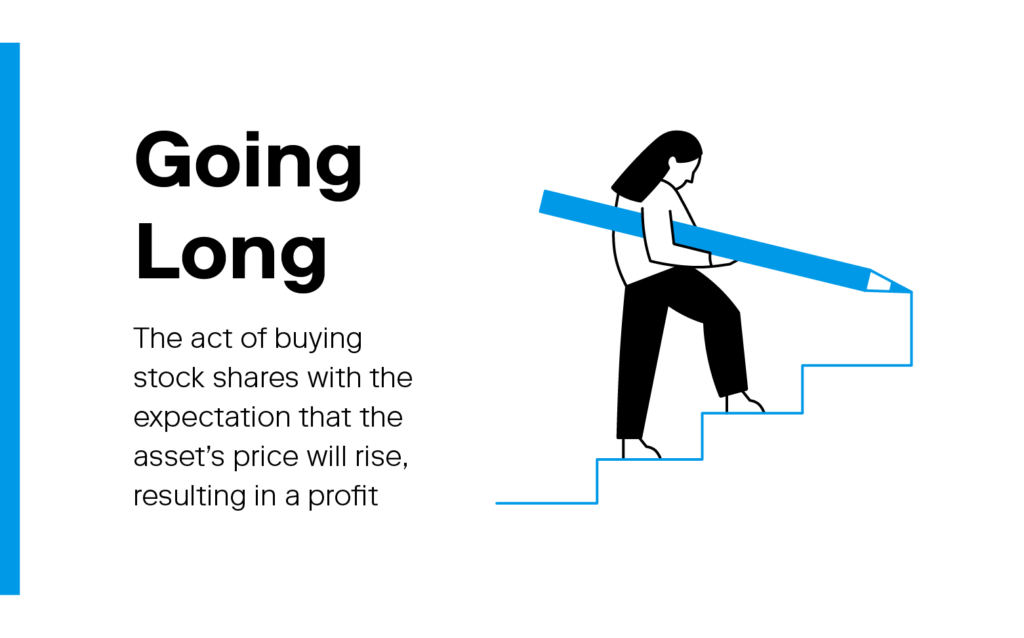Dec 8, 2023
72 Stock Market Terms Every Beginner Trader Should Know
New to investing? Dive into this breakdown of stock market terms every beginner should know.

Learning to navigate the stock market as a new investor can be intimidating, but getting familiar with basic stock market terms can get you up and running sooner than you’d think.
Understanding stock market fundamentals is key to making smart investing decisions, keeping a pulse on the market, and eventually taking on more complex trading strategies. Use the terms below to get a jump start on learning basic stock market vocabulary and create a strong foundation for your long-term wealth goals.
In this article, we’ll cover:
- Arbitrage
- Ask
- Asset allocation
- Asset classes
- Averaging down
- Bear market
- Beta
- Bid
- Bid-ask spread
- Blockchain
- Blue-chip stocks
- Bond
- Bull market
- Buyback
- Capitalization
- Capital gains
- Common stock
- Current ratio
- Day trading
- Debt-to-equity ratio
- Diversification
- Dividend
- Dividend yield
- Dollar-cost averaging
- Dow Jones Industrial Average (DJIA)
- Earnings per share (EPS)
- Economic bubble
- Equal weight rating
- Equity income
- Exchange
- Exchange-traded funds (ETFs)
- Expense ratio
- Futures
- Going long
- Going short
- Growth and income funds
- Growth stocks
- Head and shoulders pattern
- Index funds
- Inflation
- Initial public offering (IPO)
- Limit order
- Liquidity
- Margin
- Market index
- Market volatility
- Moving average
- Mutual funds
- NASDAQ
- Non-fungible token (NFT)
- Order imbalance
- OTC stocks
- Outstanding shares
- P/E ratio
- Preferred stock
- Price quote
- Profit margin
- Recession
- Risk tolerance
- Roth IRA
- Sector
- Shares
- Stock market holidays
- Stock option
- Stock portfolio
- Stock split
- Time horizon
- Value stocks
- Volume
- Volume-weighted average price (VWAP)
- Yield
- 52-week range
What is the stock market?
The stock market is a collection of markets where people buy and sell shares of publicly traded companies. When someone invests in a stock, their investment is represented by a share, or partial ownership, of that company.
The stock market operates by potential buyers naming the highest price they’ll pay for an asset (the “bid”) and potential sellers naming the lowest price they’re willing to sell for (the “ask”). Trades are typically executed by stockbrokers on behalf of individual investors.
72 stock market terms for new investors
The stock market terms below are a great starting point if you’re new to trading stocks. Study these terms to familiarize yourself with common stock lingo that any new investor should understand.
1. Arbitrage
Arbitrage refers to purchasing an asset from one market and selling it to another market where the selling price is higher than what you paid for it, resulting in profit.
2. Ask

An ask is the selling price that a trader offers for their shares.
3. Asset Allocation
Asset allocation is an investment strategy that aims to balance risk and reward by dividing a certain percentage of investments—like stocks, bonds, real estate, cash, etc.—across different assets in an investment portfolio.
4. Asset Classes
Asset classes are categories of assets, such as stocks, bonds, real estate, or cash.
5. Averaging Down
Averaging down is an investing strategy that involves buying additional shares of an asset or stock after its price has fallen, resulting in a lower average purchase price.
6. Bear Market

A bear market is a market condition in which prices are expected to fall. Typically, this entails major indexes or stocks decreasing by 20% or more compared to previous highs.
7. Beta

Beta is the measure of an asset’s risk in relation to the market. A stock with a beta of 1.5 means that the stock typically moves 50% more than the market in the same direction. Generally, a higher beta indicates a riskier investment—if the market rises 10%, the stock will rise by 15%, but if the market falls by 10%, the stock will fall by 15%.
8. Bid

The price a trader is willing to pay for shares of a stock or other asset.
9. Bid-Ask Spread

Bid-ask spread is the difference between what buyers are willing to pay and the price sellers are asking for a stock.
10. Blockchain
A blockchain is a record-keeping database in which transactions made in Bitcoin or other cryptocurrencies are recorded across multiple computers and distributed across the entire network of those computers.
11. Blue-Chip Stocks

Blue-chip stocks are common stocks of well-known companies known for their quality and history of growth.
12. Bond
A bond is a type of security loaned by an investor to a borrower like a company or government used to fund its operations.
13. Bull Market

A bull market is a market condition in which prices are expected to rise.
14. Buyback
A buyback is when a company repurchases outstanding shares to reduce the number of shares on the market and return profits to their investors, resulting in an increased value of the remaining shares.
15. Capitalization

Also known as market cap, capitalization is the total market value of all a company’s outstanding shares. It’s calculated by multiplying the total number of shares by the current share price.
16. Capital Gains
Capital gains refers to the profit earned after selling an asset or investment for a higher price than you paid for it.
17. Common Stock
This is one of the most basic stock market terms to know. Common stock is a type of security that represents ownership in a company. Holders of common stock are able to vote on matters like corporate policies and elect directors within that company.
18. Current Ratio
The current ratio is a measure of a company’s ability to pay short-term debt. It’s determined by dividing current assets by current liabilities.
19. Day Trading
Day trading is the practice of buying and selling shares of stock within a single day.
20. Debt-to-Equity Ratio
Debt-to-equity ratio represents a function of a company’s debt relative to its equity, or the value of its assets minus its liabilities. The ratio is found by dividing total liabilities by total shareholder equity.
21. Diversification
Diversification is an investment strategy that divides investment funds across a variety of assets in order to minimize overall risk.
22. Dividend

“Dividend” is one of the most basic terms for the stock market. It’s simply a portion of a company’s earnings paid out to its shareholders.
23. Dividend Yield
A dividend yield is a dividend expressed as a percentage of its stock price.
24. Dollar-Cost Averaging
Dollar-cost averaging is an investment strategy in which you invest a fixed amount on a regular basis regardless of the price of the asset.
25. Dow Jones Industrial Average (DJIA)
Also known as Dow 30, the Dow Jones Industrial Average is a stock market index consisting of the 30 most-traded blue-chip stocks on the New York Stock Exchange. It’s used to measure the performance of shares among the largest U.S. companies and gauge the overall direction of stock prices.
26. Earnings per Share (EPS)
Earnings per share is a company’s profit divided by its number of outstanding shares, and is used to measure corporate profitability.
27. Economic Bubble
An economic bubble is a situation where asset prices surge to significantly higher levels than the fundamental value of that asset.
28. Equal Weight Rating
An equal weight rating is a measure used by equity analysts to signify how well a stock is performing relative to other stocks. An equal weight rating suggests that a stock will perform similarly with the average of all the stocks being used for comparison.
29. Equity Income
Equity income is used to describe any income received from stock dividends.
30. Exchange
An exchange, or stock exchange, is a marketplace where investors and traders buy and sell stocks. You’ve probably heard of the most well-known exchanges in the U.S.: the New York Stock Exchange (NYSE) and Nasdaq.
31. Exchange-Traded Funds (ETFs)
Commonly known as ETFs, exchange-traded funds are a collection of stocks or bonds combined in a single fund that can be purchased and traded on major stock exchanges. Similar to mutual funds, they’re a pooled investment fund, meaning a “pool” of money is aggregated from multiple investors.
32. Expense Ratio
An expense ratio measures the cost of owning a mutual fund, including expenses like the management of the fund, overhead fees, and any other costs associated with running the fund. It’s essentially an administrative fee paid to the company in return for owning the fund. The ratio is measured as a percentage of your total investment—for example, if you invest $10,000 in a fund with an expense ratio of .20%, you’ll pay $20 on top of your investment.
33. Futures
A future is a contract that requires a buyer to purchase a specific asset, and the seller to sell that asset at a certain future date at an agreed-upon price. Futures are a way for investors to hedge current investments—a risk management strategy intended to offset potential losses in other investments.
34. Going Long

Going long refers to the act of buying stock shares with the expectation that the asset’s price will rise, resulting in a profit.
35. Going Short
Going short—the opposite of going long—refers to the act of selling stock shares with the expectation that the asset’s price will fall. When an investor goes short on an asset, they borrow that asset, sell it, and hopefully purchase it later at a lower price if the price does decline, resulting in profit.
36. Growth and Income Funds
This is a type of mutual fund or ETF that has both a history of capital gains (growth) and income generated from dividends (income). Growth and income funds have a two-sided strategy of both long-term growth and short-term income.
37. Growth Stocks
A growth stock is a common stock of a company whose revenues are expected to grow at a significantly higher rate than what’s average for that industry.
38. Head and Shoulders Pattern
The head and shoulders pattern refers to a specific chart formation seen on a technical analysis chart. It appears when a stock price reaches three peaks: when the price peaks then declines; rises above that peak and declines again; and rises a third time (but not as high as the second peak) and then declines again. The second peak represents the formation’s “head,” and the first and third peaks represent the “shoulders.” It’s generally considered to be an indicator of an impending bear market.
39. Index Funds
Index funds are investment funds that follow the performance of a specific benchmark or stock market index, like the S&P 500. When you invest in an index fund, your money is used to invest in every company in that index. This results in a more diverse portfolio than if you were hand-selecting individual stocks, for example.
40. Inflation
Inflation is the rate of increase in prices for goods and services in the economy.
41. Initial Public Offering (IPO)
An IPO refers to a previously private company that becomes public by selling stock
shares on the stock market.
42. Limit Order
A limit order is an order to buy or sell a stock at or below a specific price. Limit orders give traders control over how much they pay.
43. Liquidity
Liquidity measures how quickly and easily a stock can be bought or sold without impacting its price. Cash, for example, is the most liquid asset—no exchange is necessary to gain value from it, and it’s already in its most liquid form. On the other hand, a car is less liquid—regardless of its value, you might have to wait to sell it at its best price.
44. Margin
Sometimes referred to as “buying on margin,” margin is when investors borrow money from a broker to purchase a stock, similar to a loan.
45. Market Index
A market index tracks the performance of a certain collection of stocks, often grouped to represent a certain industry. They’re a tool for investors to gauge the health of the stock market by comparing current and past stock prices.
46. Market Volatility
Market volatility is a measure of how much and how often the value of the stock market fluctuates.
47. Moving Average
A moving average is the average price of stocks or other assets over a specific period of time. Generally used in technical analysis charts, it’s calculated by averaging data from the previous time periods to help investors identify the current direction of price trends.
48. Mutual Funds
Mutual funds are pools of investments from shareholders used to “mutually” buy securities like stocks, bonds, and other assets.
49. Nasdaq
Nasdaq, or National Association of Securities Dealers Automated Quotations, is an electronic exchange where investors can buy and sell stocks through an automated network of computers. It’s the second-largest stock exchange in the world, following the NYSE.
More broadly, Nasdaq can also refer to the Nasdaq Composite Index, a stock market index of over 3,300 companies listed on the Nasdaq exchange. In this context, it can be thought of similarly to other indexes like the DJIA or the S&P 500.
50. Non-Fungible Token (NFT)
A non-fungible token, more commonly known as an NFT, is a blockchain-based financial security. Each NFT represents a unique digital asset. “Non-fungible” indicates that it can’t be replicated or replaced with something else.
51. Order Imbalance
An order imbalance occurs when orders of one type of stock aren’t offset by opposite orders, resulting in an excess of orders for that specific stock and sometimes volatile price changes.
52. OTC Stocks
OTC stocks, or over-the-counter stocks, are securities that are traded on a broker-dealer network instead of on a major U.S. stock exchange. They’re often used by smaller companies who don’t meet the requirements to be listed on a formal stock exchange.
53. Outstanding Shares
Outstanding shares refers to the total number of a company’s shares that have been issued to shareholders, including restricted shares.
54. P/E Ratio
Used to value a company, the P/E ratio, or price-earnings ratio, is the ratio of a company’s share price to the company’s earnings per share.
55. Preferred Stock
Preferred stock is a type of stock that combines characteristics of both common stock and bonds. Owners of preferred stock receive different rights than common stockholders, like receiving dividends before common stockholders, but they generally don’t come with corporate voting rights like common stocks do.
56. Price Quote
A price quote is the price of a stock or other security as quoted on an exchange. Price quotes usually come with important supplemental information to help traders make more informed investment decisions.
57. Profit Margin
Profit margins are used to gauge the profitability of a company. It’s expressed as a percentage and is calculated by dividing the company’s net profit (total revenue minus total expenses) by total revenue.
58. Recession
A recession is defined as a period of decline in economic performance throughout the economy, generally lasting for at least several months.
59. Risk Tolerance
Risk tolerance is a measure of the level of risk you’re willing to accept on your investments. Someone with a lower risk tolerance typically sees lower returns on their investments in exchange for lower overall risk in periods of market decline.
60. Roth IRA
A Roth IRA is an individual retirement account that allows you to contribute after-tax dollars, allowing your earnings to grow and be withdrawn tax-free.
61. Sector
The stock market includes shares from thousands of different companies, which are broken into 11 different sectors. A sector is a group of companies with similar business products, services, or characteristics.
62. Shares
Shares are units of ownership in part of a company’s total stock.
63. Stock Market Holidays
While this isn’t necessarily a term or definition, it’s important to know what days you can and can’t buy or sell on the U.S. stock exchange. The U.S. stock market observes 10 holidays a year, closing on those days. In 2023, the observed holidays are New Years Day, Martin Luther King Jr. Day, President’s Day, Good Friday, Memorial Day, Juneteenth National Independence Day, Independence Day, Labor Day, Thanksgiving, and Christmas.
64. Stock Option
A stock option is a contract that gives an investor the right to purchase or sell a specific number of stock shares at a predetermined price within a specified time period.
65. Stock Portfolio
A stock portfolio is an individual’s collection of investments, including stocks, bonds, mutual funds, and other financial assets. While a portfolio refers to all of your investments, they might not be contained in one single account.
66. Stock Split
A stock split occurs when a corporation increases the number of its outstanding shares by distributing more shares to current stockholders. By splitting existing shares into multiple new shares, the stock becomes more affordable.
67. Time Horizon
Time horizon refers to the period of time an investor expects to hold an investment, which will vary based on personal investment goals and strategies. For example, investing in a retirement account like a 401(k) has a longer time horizon, since the funds won’t be withdrawn until you reach retirement age. Generally speaking, longer time horizons correlate to more risk potential in a portfolio, and shorter time horizons correlate to a more conservative (less risky) portfolio.
68. Value Stocks
Value stocks are shares of companies selling at bargain prices that investors expect to rise because the company’s financial fundamentals suggest the shares are actually worth more than the current value.
69. Volume
Volume is a measure of how much a certain stock or other investment has been traded over a certain period of time. Volume is a critical component of strategically analyzing stock market trends, and is often used to determine market strength.
70. Volume-Weighted Average Price (VWAP)
Volume-weighted average price (VWAP) is a measure of the average trading price of a stock or other asset, adjusted for volume. It’s calculated by dividing the total dollar value of trading in that asset by the volume of trades.
71. Yield
Yield refers to the income earned on an investment over a set period of time, expressed as a percentage of your original investment.
72. 52-week Range
The 52-week range is a technical indicator that measures the lowest and highest price of a stock traded during a 52-week period. Traders use this measure to analyze current stock prices and predict its future movements.
Learning to navigate the stock market and stock trade terms for the first time might feel daunting, but consider this your official first step on the path to developing your investing muscles. When you come across a term you’re unfamiliar with in your own research, refer back to this post until you’ve mastered them. You’ll find that learning these stock terms for beginners is more doable than you think.
The more time you invest in learning stock market terms and fundamentals, the more confident you’ll become as an investor. And if you’re looking for a little more support, consider turning to a platform like Stash. We make it easy to invest what you can afford on a set schedule, all the while providing unlimited financial education and personalized advice based on your risk level—so you can start building long-term wealth, even if you’ve never invested before.

Investing made easy.
Start today with any dollar amount.


FAQs About Stock Market Terms
Have more questions about stock market terms? We have answers.
Why Should You Know Stock Market Terms?
Establishing a working knowledge of stock market terms forms the foundation for the rest of your investment journey. It’s the gateway to crafting a strategic market approach, understanding different trading strategies, and making sense of market fluctuations that will inform your future trading decisions.
How Do You Buy Stocks?
Before investing a dollar, get clear on your investment goals—this informs everything from your investment timeline to the specific investments you’ll choose. From there, the process of buying your first shares of stock is surprisingly easy:
- Open a brokerage account
- Research what stocks you want to buy
- Determine how much you can afford to invest
- Purchase your first share
- Maximize returns with a buy and hold strategy
What Are the Most Used Stock Market Terms?
The most used stock market terms include bear market, bull market, dividend, ask, bid, and blue-chip stocks.
Related Articles

15 Largest AI Companies in 2024

The 12 Largest Cannabis Companies in 2024

What Is a Traditional IRA?

Saving vs. Investing: 2 Ways to Reach Your Financial Goals

How To Invest in the S&P 500: A Beginner’s Guide for 2024

Stock Market Holidays 2024





